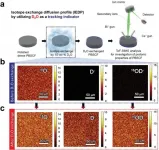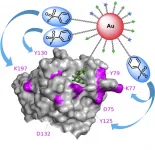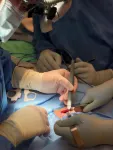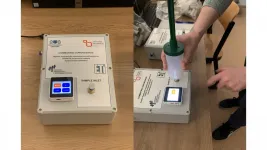Asymptomatic adults may be reservoirs of Streptococcus pneumoniae
Study by ITQB NOVA researchers identifies role played by adults in the carriage of pneumococci
2021-07-06
(Press-News.org) Streptococcus pneumoniae is a major human pathogen and a leading cause of several infectious diseases including pneumonia, the third-leading cause of death in Portugal. In Europe, S. pneumoniae is the most common cause of community-acquired bacterial pneumonia in adults. Still, very little is known about its colonization within this age group. A team of researchers from ITQB NOVA has now taken a crucial step to clarify the dynamics of carriage of this bacterium in adults.
This bacterium, also known as pneumococcus, can asymptomatically colonize the human upper respiratory tract. Colonization not only precedes diseases but is also essential for transmission. Even though pneumococcal disease is most common among children and the elderly, it is relatively rare among active healthy adults. Now, researchers have discovered that, contrary to expectations, in this age group acquisition of pneumococcus is frequent and carriage can last several months.
In the work published in the Journal of Infectious Diseases, the team led by Raquel Sá-Leão followed for six months 87 healthy adults aged 25-50 in Portugal. Nasopharyngeal, oropharyngeal, and saliva samples were collected periodically, and screened using molecular methods, such as real-time PCR, for the presence of pneumococcus. The use of qPCR enables high sensitivity in samples where pneumococci are at low density. "Sampling of multiple sites using a high-sensitive method together with repeated sampling of subjects allowed us to increase the chance of detecting carriage events", explains Sónia Almeida, first author of the study developed during her PhD.
Researchers concluded that colonization among healthy adults was relatively frequent. In fact it was estimated that "the risk of an adult being colonized with pneumococci at least once during a period of one year was 57.5%", says Ana Cristina Paulo, second author of this study. Moreover, it was estimated that the median duration of carriage was almost two months, which is higher than previous studies had reported. Strikingly, some adults carried pneumococcus for more than 6 months - the duration of the study. Adults who lived with children showed a higher risk of acquiring pneumococcus. However, the duration of carriage in adults did not depend on regular contact with kids.
The research suggests that some adults can act as reservoirs of pneumococci. Therefore, the scale of herd immunity potentially attainable through children's vaccination, which protects the community from infectious diseases, may vary. "These outcomes are central when designing strategies to prevent pneumococcal disease in adults. By understanding this dynamic, we can contribute to public health decisions", adds Raquel Sá-Leão.
The team of ITQB NOVA's Laboratory of Molecular Microbiology of Human Pathogens developed this study in collaboration with ITQB NOVA PI Hermínia de Lencastre and the pneumologist Filipe Froes. The Sá-Leão Lab researches how human interventions, such as the use of antibiotics and vaccines, impact on the nasopharyngeal microbiota, with special interest on Streptococcus pneumoniae.
INFORMATION:
[Attachments] See images for this press release:
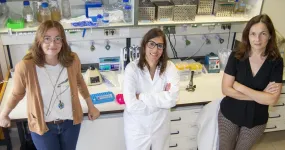
ELSE PRESS RELEASES FROM THIS DATE:
2021-07-06
In 2011, scientists confirmed a suspicion: There was a split in the local cosmos. Samples of the solar wind brought back to Earth by the Genesis mission definitively determined oxygen isotopes in the sun differ from those found on Earth, the moon and the other planets and satellites in the solar system.
Early in the solar system's history, material that would later coalesce into planets had been hit with a hefty dose of ultraviolet light, which can explain this difference. Where did it come from? Two theories emerged: Either the ultraviolet light came from our then-young sun, or it came from a large nearby star in the sun's stellar nursery.
Now, researchers from the lab of Ryan Ogliore, assistant professor of physics in Arts ...
2021-07-06
The neocortex is a layered structure of the brain in which neurons are arranged parallel to each other. This organization is critical for healthy brain function. A team of researchers from Charité - Universitätsmedizin Berlin have uncovered two key processes that direct this organization. Reporting in Science Advances*, the researchers identify one crucial factor which ensures the timely movement of neurons into their destined layer and, subsequently, their final parallel orientation within this space.
The neocortex is the outer region of the brain. It is responsible for cognitive functions such as language, decision-making, and ...
2021-07-06
A research team, led by Professor Guntae Kim in the School of Energy and Chemical Engineering at UNIST has introduced an innovative way to quantify proton kinetic properties of triple (H+/O2?/e?) conducting oxides (TCOs) being a significant indicator for characterizing the electrochemical behavior of proton and the mechanism of electrode reactions.
Layered perovskites have recently received much attention as they have been regarded as promising cathode materials for protonic ceramic fuel cells (PCFCs) that use proton conducting oxide (PCO) as an electrolyte. Therefore, quantitative characterization of the proton kinetics in TCO can be an important indicator providing a scientific ...
2021-07-06
Psychologists from UNSW Sydney have developed a new face identification ability test that will help find facial recognition experts for a variety of police and government agencies, including contract tracing.
The Glasgow Face Matching Test 2 [GFMT2] targets high-performing facial recognition individuals known as super-recognisers, who have an extraordinary ability to memorise and recall faces.
The type of professional roles that involve face identification and that could benefit from the test include visa processors, passport issuers, border control officers, ...
2021-07-06
Cells play a precise game of telephone, sending messages to each other that trigger actions further on. With clear signaling, the cells achieve their goals. In disease, however, the signals break up and result in confused messaging and unintended consequences. To help parse out these signals and how they function in health -- and go awry in disease -- scientists tag proteins with labels they can follow as the proteins interact with the molecular world around them.
The challenge is figuring out which proteins to label in the first place. Now, a team led by researchers from Tokyo University of Agriculture and Technology (TUAT) has developed a new approach to identifying and tagging the specific proteins. They published their results on June 1 in Angewandte ...
2021-07-06
AUSTIN, Texas -- A diagnostic tool called the MasSpec Pen has been tested for the first time in pancreatic cancer patients during surgery. The device is shown to accurately identify tissues and surgical margins directly in patients and differentiate healthy and cancerous tissue from banked pancreas samples. At about 15 seconds per analysis, the method is more than 100 times as fast as the current gold standard diagnostic, Frozen Section Analysis. The ability to accurately identify margins between healthy and cancerous tissue in pancreatic cancer surgeries can give patients the greatest chance of survival.
The results, by a team from ...
2021-07-06
TORONTO, July 6, 2021 - What's stressing out bumblebees? To find out, York University scientists used next-generation sequencing to look deep inside bumblebees for evidence of pesticide exposure, including neonicotinoids, as well as pathogens, and found both.
Using a conservation genomic approach - an emerging field of study that could radically change the way bee health is assessed - the researchers studied Bombus terricola or the yellow-banded bumblebee, a native to North America, in agricultural and non-agricultural areas. This new technique allows scientists to probe for invisible stressors affecting bees.
Like many pollinators, the yellow-banded bumblebee ...
2021-07-06
A collaborative research project between the five First Nations of the Nanwakolas Council of B.C. and Simon Fraser University is contributing to conservation efforts of the iconic western redcedar tree.
New research in the Journal of Ethnobiology highlights concerns about the long-term sustainability of this culturally significant resource. Researchers found that western redcedar trees suitable for traditional carving are generally rare. Some important growth forms, such as large, spectacular trees appropriate for carving community canoes, are nearly extirpated from ...
2021-07-06
WASHINGTON, July 6, 2021 -- Emitted as gases from certain solids or liquids, volatile organic compounds (VOCs) include a variety of chemicals. Many of these chemicals are associated with a range of adverse human health effects, from eye, nose, and throat irritation, to liver, kidney, and central nervous system damage.
The ability to detect VOCs in air samples simply, quickly, and reliably is valuable for several practical applications, from determining indoor air quality to screening patients for illnesses.
In Review of Scientific Instruments, by AIP ...
2021-07-06
Mammals have a poor ability to recover after a spinal cord injury which can result in paralysis. A main reason for this is the formation of a complex scar associated with chronic inflammation that produces a cellular microenvironment that blocks tissue repair. Now, a research team led by Leonor Saude, group leader at Instituto de Medicina Molecular Joao Lobo Antunes (iMM; Portugal) and Professor at Faculdade de Medicina da Universidade de Lisboa, have shown that the administration of drugs that target specific cellular components of this scar, improve functional recovery after injury. The results now published in the scientific journal Cell Reports* set the basis for a new promising therapeutic strategy not ...
LAST 30 PRESS RELEASES:
[Press-News.org] Asymptomatic adults may be reservoirs of Streptococcus pneumoniae
Study by ITQB NOVA researchers identifies role played by adults in the carriage of pneumococci



